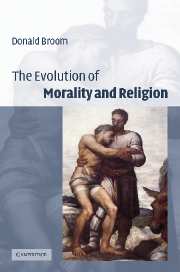Book contents
- Frontmatter
- Contents
- Preface
- Acknowledgements
- 1 Concepts and codes of living
- 2 Cooperation, altruism, reciprocal altruism
- 3 Biological capabilities needed for altruism and morality
- 4 Ideas about morality
- 5 The origins and value of religion
- 6 Other views about the origins of morality and religion
- 7 Social and political consequences of this biological view of morality and religion
- 8 Conclusions
- References
- Species list
- Author index
- Subject index
1 - Concepts and codes of living
Published online by Cambridge University Press: 18 December 2009
- Frontmatter
- Contents
- Preface
- Acknowledgements
- 1 Concepts and codes of living
- 2 Cooperation, altruism, reciprocal altruism
- 3 Biological capabilities needed for altruism and morality
- 4 Ideas about morality
- 5 The origins and value of religion
- 6 Other views about the origins of morality and religion
- 7 Social and political consequences of this biological view of morality and religion
- 8 Conclusions
- References
- Species list
- Author index
- Subject index
Summary
CONCEPTS OF MORALITY AND RELIGION
Something is moral if it pertains to right rather than wrong. The question of what is right, or good, or beneficial is discussed further in Chapter 4, Section 1 but, as Midgley (1994 pp. 13–14) has emphasised, morality should not be thought of as a topic which is obscure and difficult to comprehend. We each have many clear ideas about actions which are good or not good. Planalp (1999 p. 161) states that:
To behave morally is to judge right and wrong, good and bad, and to behave accordingly.
Hence decisions about moral issues are taken many times during every day. People ‘behave morally’ most of the time and often discuss questions of what is right or wrong. In doing this they express an interest in ethics which is the study of moral issues.
Most people who refer to moral acts are considering a circumstance where there is some interaction with other individuals. These individuals that are the subject of moral acts are often, but not necessarily, of the same species. They are usually alive at the time of the act but the action may affect individuals at a later time or may affect those as yet unborn. The idea that another individual is affected by a moral action is clear in Rottschaefer's (1998, p. 42) statement:
Moral actions and intentions can be discussed either in terms of providing benefits or in terms of refraining from harming.
- Type
- Chapter
- Information
- The Evolution of Morality and Religion , pp. 1 - 29Publisher: Cambridge University PressPrint publication year: 2003



